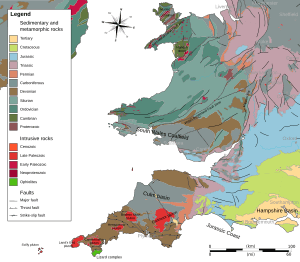Geology of South Wales
South Wales is a super interesting place for anyone who loves rocks and Earth's history! Geologists, who are scientists who study the Earth, have been coming here for a long time. It's a great spot for university students to learn about geology.
People have been studying the rocks in South Wales for a really long time. As far back as the 1100s, a writer named Giraldus Cambrensis noticed shiny rocks called shales near Newport. Later, in the late 1600s, some of the first drawings of fossil plants from coal measures near Neath were published. Famous British geologists like Adam Sedgwick and Roderick Murchison did really important work here, studying the Old Red Sandstone and older rocks beneath it. The British Geological Survey, a group that maps the Earth's geology, even published a big report on South Wales in 1846. This report helped guide all future studies.
Even today, new things are being found! For example, in the late 1970s, a geologist named John Cope found a small area with very old rocks from the Precambrian and Cambrian periods in Carmarthenshire. The geology of South Wales was also super important during the Industrial Revolution because of its rich coal deposits.
Contents
Earth's Ancient Timeline in South Wales
South Wales has rocks from many different time periods in Earth's history. These are called geological periods. You can find rocks from all the Palaeozoic periods, which are very ancient.
The Oldest Rocks: Precambrian and Cambrian
In Pembrokeshire, you can see rocks from the Precambrian and Cambrian periods. The Cambrian period was about 542 to 488 million years ago!
Ordovician and Silurian Periods
The Ordovician period (488-444 million years ago) saw a huge dip in the land, like a giant bowl, called a basin. This basin slowly filled up with thick layers of sand and mud. To the southeast, there was a shallower area, like a continental shelf. Some volcanoes also erupted during this time.
This piling up of sediments continued into the Silurian period (444-416 million years ago). During the Silurian, volcanoes on places like Skomer Island produced lava. You can see Silurian rocks in many parts of South Wales, especially along the Cardiganshire coast.
Mountains Rise!
The rocks from the Silurian and earlier periods were bent, broken, and squished many times. This happened especially during the late Ordovician and late Silurian. At this time, the land started to rise above sea level, and mountains pushed up to the northwest. This was caused by two huge landmasses, like giant puzzle pieces, crashing together. One was a very old North America (called "Laurentia"), and the other was what is now southern Britain (called "Eastern Avalonia"). The ocean between them, called the Iapetus Ocean, closed up because of how Earth's plate tectonics move. This is similar to how the Mediterranean Sea is slowly closing today as Europe and Africa move closer.
Devonian and Carboniferous Periods
The next period was the Devonian (416-359 million years ago). During this time, most of the deposits were sand and mud carried by rivers, forming what we call the "Old Red Sandstone". This was interrupted by major uplift, meaning the land pushed up again.
After this, the land sank again in the Carboniferous period (359-299 million years ago). In the early Carboniferous, limestones formed on a continental shelf. This shelf got deeper towards the south, where there was a large sea. Later, as continents moved closer, the sea became shallower. This led to thick layers of river and coastal plain sediments, which contained important coal deposits. You can see Carboniferous Limestone rocks in places like south Pembrokeshire, the Gower Peninsula, the Vale of Glamorgan, and around the edge of the coalfield.
Later Periods: Permian, Triassic, and Jurassic
At the end of the Carboniferous, during the Permian period (299-251 million years ago), Wales is thought to have been dry land. It wasn't until the late Triassic period (251-200 million years ago) that new deposits started to form. These included piles of rough, broken rocks around low hills.
Later, muddy rocks and muddy limestones (called the "Lias") formed during the early Jurassic period. Rocks from even later periods are mostly gone now, probably worn away by wind and water. However, it's thought that a sea that formed the Chalk (like the White Cliffs of Dover) probably covered most of Wales between 100 and 66 million years ago.
Special Rocks and Features
Sutton Stone: A Rare Find
One of the special and rare geological features in South Wales is found along the coast near St Brides Major at Ogmore-by-Sea and Southerndown. The cliffs here are partly made of a very early Jurassic rock called Sutton stone. This is a rare type of freestone, which means it's a stone that can be cut easily. It formed near the coast from the wearing away of older Carboniferous limestone.
Sutton stone was always highly valued. People used it for building throughout the Vale of Glamorgan. It was even shipped across the Bristol Channel to places like North Devon and North Cornwall, which didn't have much limestone of their own.
The South Wales Coalfield
A very important geological feature in South Wales is the south Wales coalfield. The rocks that make up this area were laid down during the later Carboniferous period. These layers of rock are incredibly thick, more than 1,800 meters (about 5,900 feet) in the west!
The coal measures formed on a flat, wet area with lots of squishy peat. This area was just south of an ancient geological feature called the Wales-London-Brabant High. Over a very long time, the peat got buried deep underground. The pressure and heat turned it into thinner layers of coal. Later, Earth's movements bent and twisted these coal layers. This made mining the coal very difficult, and many mines had to close early because it was too hard or expensive to get the coal out, especially in Pembrokeshire where the coal seams were completely squished out of shape.


